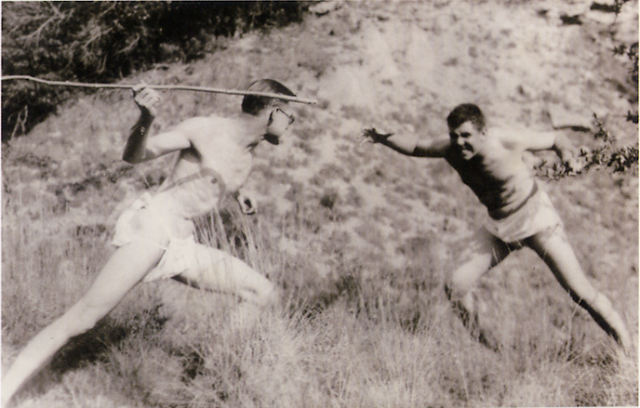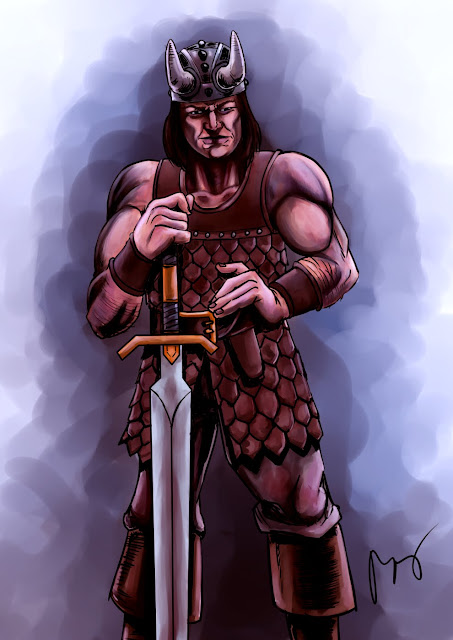 On the 22nd of January, 1906, Robert Ervin Howard let his first primal scream be heard by this world in Peaster, Texas. Little did his parents, a travelling physician Isaac Howard and Hester Howard, know, that this boy and his works would still be remembered long after his death.
On the 22nd of January, 1906, Robert Ervin Howard let his first primal scream be heard by this world in Peaster, Texas. Little did his parents, a travelling physician Isaac Howard and Hester Howard, know, that this boy and his works would still be remembered long after his death.The early years of young Robert's life were spent on the road as his parents had to go where Isaacs's work took them. He was already 7-years old when Isaac finally got a more permanent position as a doctor in the town of Bagwell, Texas. Bawell was also the town, where Robert entered the school at the age of eight.
At home, life wasn't happy though. The marriage of Hester and Isaac had begun to turn sour as Isaac wasn't very good with money and Hester had begun to suspect that she might have married below her class. This led to many quarrels between the parents.
It wasn't just his parents fighting, that might have marked the mind of young Robert. He had the front-row seat on violence, death, crime and gore at the practices of Isaac. As Bagwell was an oil boom town, he was surrounded from a young age by tales of feuds, gunfights and Indians as well.
One of the influencers was a former slave, a cook Mary Bohannon, who told ghost stories to young Robert. These stories became a basis for one of the most acclaimed pieces Robert was to write, a grim ghost story the Pigeons From Hell. Of these traces, Robert, later on, wrote to his pen-pal H. P. Lovecraft.
Hester took an active interest in Robert's education and intellectual growth and preferred Isaac not to take part in those kinds of matters. Through her mother, Robert gained a love for literature and poetry and it was she, who encouraged the young boy to write his own stories.
 |
| Robert E. Howard is around 8-years old |
It wasn't only literature that occupied the young writer, he also became a boxing fan. And not only was he a fan of boxing, but he also boxed himself as well. This interest is something that also found its way into his works. Some of his boxing tales were comedic, like the adventures of a heavy-fisted sailor Steven Costigan, but some were more serious in tone, describing the sport more truthfully, in only a way someone who has tried the sport and has a deep appreciation towards it, can do.
At the age of 13, the Howard family moved again, this time to Cross Plains, Texas, where Robert spent most of his life except for short stints in places like Brownwood, where he finished college.
In 1924 Robert E. Howard became a published author after he managed to sell his short story, Spear and Fang to a pulp magazine Weird Tales. He got 16 dollars, around 240 dollars in current money, for this short caveman story about two cavemen fighting over the love of a woman.
Robert spent his days doing odd jobs for money while getting his stories released occasionally by the Weird Tales. The first story he managed to get to the cover of the magazine was Wolfshead, a tale about werewolves. He was barely 20 at the time.
Exhausted by the odd jobs, Howard returned to college in 1926 to attend a bookkeeping course. During this time he wrote "The Shadow Kingdoms", a story that was published in 1929 in Weird Tales, introducing King Kull and the beginnings of his own Hyperborean mythos. By then he had several ongoing series, like King Kull, Solomon Kane and Steven Costigan. He was only 23 at the time, but he was already making living as an author.
 |
| Robert E. Howard with his friend Tevis Clyde Smith |
In 1930, Robert wrote a letter to the editor of Weird Tales, praising a story The Rats in the Walls. This letter was redirected to the writer of the said story, H. P. Lovecraft and from this began the friendship of these two authors. Not only did he become a part of Lovecraft's vast circle of writer friends, but he also began to use the mad Cthulhu mythos Lovecraft had created in his own works.
 |
| Novalyne Price |
Howard grew as a writer, expanding to other genres. Westerns, horror, sports stories, and even detective stories. He did them all, even creating a genre of Weird Westerns, which add elements of horror to the mix.
In 1936 it looked like Howard would finally move from magazines to hardcover books. He was deep in writing westerns, his character Breckinridge Elkins in the front row. He was reworking the tales of this dimwitted mountain man into a book that would be published by a British publisher Herbert Jenkins.
But his personal life wasn't easy for him. One by one, his friends were married while the only woman Howard himself had ever loved, besides his mother, Novalyne Price, had left Cross Plains to graduate school and Weird Tales was in a slump, unable to pay Howard for his stories. On top of that, his mother was finally succumbing to tuberculosis after having suffered from it for years.
 |
| Hester Howard |
Robert E. Howard, only 30 years old at the time, walked out to his car and took a pistol he had borrowed from a friend from the glove box. He shot himself in the head but did not die immediately. For eight more hours, he clung to life before passing on. Hester Howard died the following day.
June 14th a double burial was held at the Cross Plains First Baptist Church, where the mother and the son were buried in a plot bought by Robert E. Howard himself a bit earlier.
From what I've read, it seems that Robert E. Howard had known for a good while how he was to die. Before his suicide, he had borrowed a gun, bought a burial spot and made arrangements whit his agent on grounds of how to handle his works after his death. Novalyne Price understood only after Howard's suicide, that he had given veiled hints of his plans for a good while.
But so passed Robert E. Howard. A troubled man with a head full of stories he poured to the paper at an astonishing speed. Perhaps he always knew his life would be a short one, so he worked as hard as he could to get out all he wanted.
Leaving behind a literary legacy of hundreds of stories and poems, he is now remembered better than many of the other writers of his era. While he was criticized during his time, his works have long lasted his then peers and critics, still sparking the imagination of many new readers each year.
With Conan alone, Robert E. Howard became larger than life. And that is something not many writers can claim.

Comments
Post a Comment